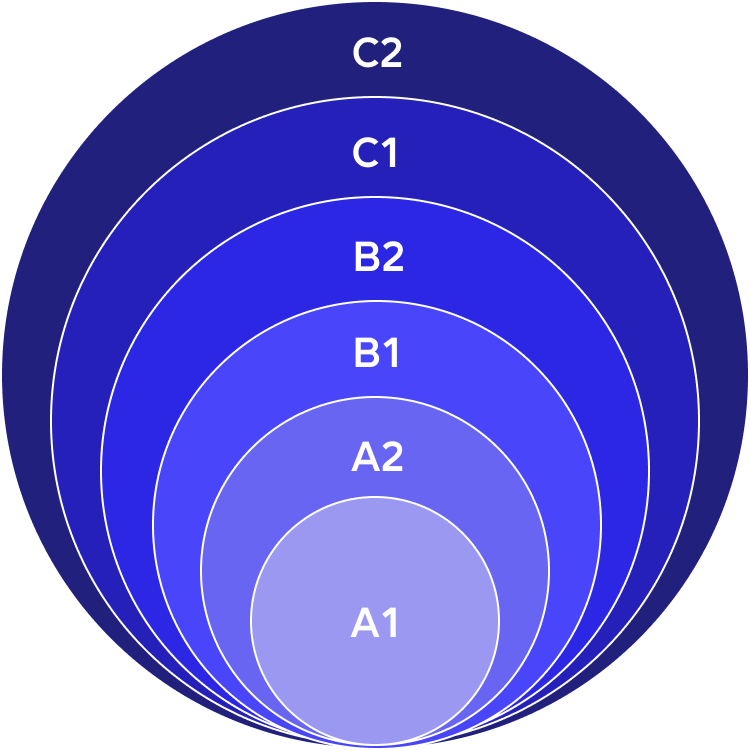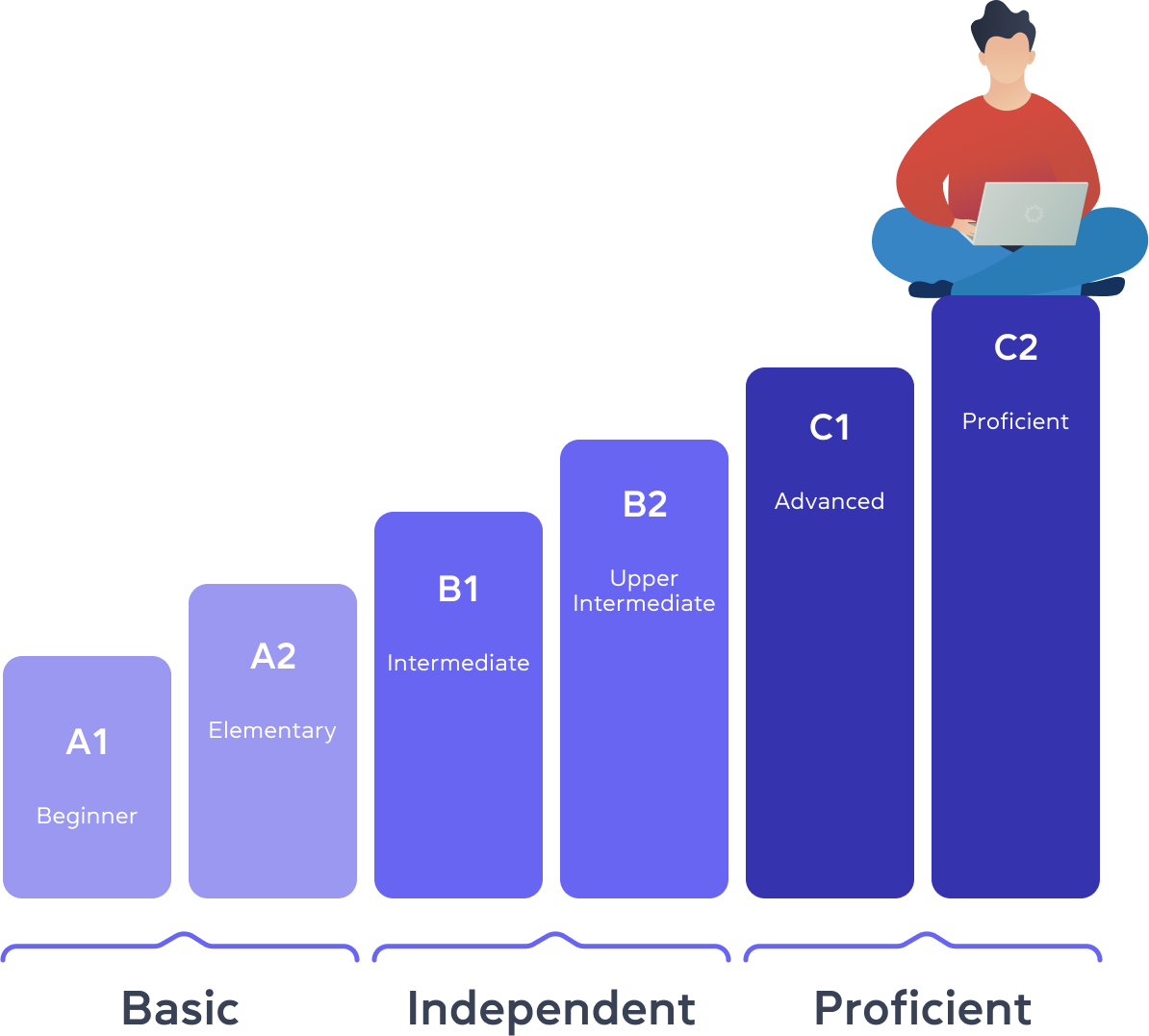How to support English language learners with formative assessment
- Tips & Strategies
- Methodology

28.06.2023
“When is the right time to present certain grammar?” is one of the most popular questions among English teachers. It must be as functional as possible, not too complicated, sometimes we even have to tell half the truth. Indeed, how should we explain fixed-future arrangements to A2 students during the Present Continuous presentation? The question is whether there is any guidance that can help teachers to decide how and what to present in grammar classes.
Well, let’s talk about one of them.

The conversation about the levels is impossible without mentioning CEFR classification, a set of requirements that a learner of a “foreign” language must meet to prove their ability to use the language within a certain level’s frame. Introducing such a system can’t be underestimated as it has been successfully used to
promote new approaches, develop teaching skills, design new programs, and ease the evaluation of competence.
The CEFR classifies linguistic competence into six levels. All of them can be further classified into three broad categories: Basic User (A1, A2), Independent User (B1, B2), and Proficient User (C1, C2), depending on the demands of the local context. “Can-do” descriptors are used to define the levels.

Of course, these levels did not just arise in 2001 (a year CERF classification was presented) out of the air. They have been developed gradually through time and finally collected into one system which is commonly used to evaluate students’ knowledge and in short describe how complex their abilities are.
So, talking about the specific grammar structures which you should teach at each level, we are going to refer to CERF requirements.
CERF Requirements | Personal Pronouns | These are easy words that are a great tool for building the first phrases |
| Possessive Adjectives & Possessives | This grammar is essential to proceed with learning to talk about ourselves and our friends (family, work, hobby, etc.) | |
| Have got | A nice alternative before students get to know Present Simple questions. However, you should be ready to briefly explain the difference between “Do you have?” and “Have you got?” as the first structure may be heard by the students before, therefore they might have questions. | |
| This/That vs These/Those | Useful to describe places and objects. | |
| Cardinal & Ordinal Numbers | Essential to name the quantity or the order. | |
| Prepositions of time and place | It is quite necessary to begin working with prepositions straight from the beginning. Moreover, it is something that seems to be both super common and confusing or lacking in any logic for students, so some clarity will be needed. | |
| to be (for the present) | The first grammar structure that gives an opportunity to compose the first simple sentences and questions on different topics. | |
| Present Simple (I, you, we, they, he, she, it): affirmative sentences, questions, and negative sentences. | The first tense students may use to talk about routine and habits as well as the first topic which students usually find difficult because of the difference between to be and other verbs’ sentences. | |
| Verb + ing: like/hate/love | Students often have to express their likes and dislikes, so CERF advises familiarizing students with these gerund phrases although students don’t know what gerund is. | |
| There is/There are | Although the students often require additional explanations at this point as those who are used to literal translation to L1, it is a rather important step to take toward describing places and things. | |
Countable/Uncountable Nouns, Quantifiers | Students should be taught to see the difference between countable and uncountable nouns as well as choose between a/an/some/any/much/many/few/a few/little/a little | |
| Imperatives | One of the most useful topics for basic users as it provides them with the ability to ask for something or give commands. | |
| I’d like/ Would you like? | A useful phrase to teach students and in this way give them the ability to express their wishes. | |
| Modal verbs (can/can’t for permission and ability) | A structure that enables students to express their abilities and ask or give permission | |
| Comparatives and Superlatives | Even at this point we often need to compare and contrast things, so explaining the rules of building comparative and superlative forms is a must. | |
| to be (for past) | The first step to unlocking the skill of talking about the past | |
| Past Simple | Give a complex image of how to talk about past experiences correctly. | |
| Present Continuous | Students get the tool of expressing what they are doing right now or around now. | |
| Future Simple | Students get the idea of how to talk about general future or on-the-spot decisions. | |
| To be going to | This structure is the easiest way to give students a tool to talk about the future as soon as they learn “to be” rules. | |
| Present Perfect | Students learn how to talk about results/lack of results, experience, etc. | |
| Present Perfect vs Past Simple | Students learn to see the difference between tenses. |

| CERF Requirements | Present Simple vs Present Continuous | Revision |
| Past Simple | Revision | |
| Present Perfect vs Past Simple | Revision | |
| Modals (have to/should, must, can) | Although it is often hard for students to grasp all the peculiarities of the modal verbs’ meaning, it is another essential grammar topic that covers such needs of beginners as talking about skills, giving recommendations, describing responsibilities, etc.). | |
| will, may, might | Students practice using different degrees of uncertainty. | |
| Conditional Type 1 | A2 level is a good time for the first meeting with conditional sentences. | |
| Conditional Type 1 vs Conditional Type 2 | It is also recommended to compare the usage of Conditional Type 2 and Type 1. | |
| Past Continuous (+ Past Simple Revision) | At this point students are supposed to know Past Simple, so after presenting Past Continuous, you can focus on noticing the continuous aspect. | |
| used to | Students learn to talk about their past habits. | |
| Gerunds | Students are exposed to a bigger variety of common words and phrases after which we use gerunds. | |
| Future: to be going to vs Present Continuous for future | It is also time for students to work on spotting the difference between general plans and intentions and fixed-future arrangements. | |
| Passive (Present Simple and Past Simple) | In addition, it is high time to make the first steps in discovering Passive voice for basic tenses. |

What is guided discovery in ELT?
Find out
CERF Requirements | Narrative tenses (Past Simple and Past Continuous revision, Past Perfect presentation) | Students revise Past Simple and Past Continuous as well as compare their usage with Past Perfect which is new for them at this point. |
| Future forms (Present Continuous, to be going to, Future Simple revision) | Students are ready to combine all their knowledge of future structures and try choosing between them (fixed-future arrangement, general plan, intention, on-the-spot decision, etc) | |
| Will and going to, for prediction | It is also advised to broaden the basic meaning of will and to be going to and explain how both structures can be used for predictions. | |
| Modals – must/can’t deduction | It is also a good idea to explain to your students that some modal verbs have different functions and can be used in more complicated contexts than those that you discussed before. | |
| Modals – might, may, will, probably | It is also high time for the students to learn how to express the degrees of certainty and uncertainty. | |
| Modals – should have/might have/etc | CRF also advises taking the first glimpse into past modals and learning how to use and rebuild the familiar modal structures and express past ideas using them. | |
| Present Perfect vs Present Perfect Continuous | Present Perfect Continuous can be presented at this point. Students are also supposed to be able to compare it with Present Perfect which is already known to them. | |
| Complex questions tags | Students are also ready to broaden their knowledge of questions and learn how to use other pretty common types of questions. | |
| Passive voice (Present Simple and Past Simple revision + other tenses) | B1 is good for starting the discussion about passive too as at this point students gradually question how to make a passive sentence. Students may not be ready to talk about all tenses, however, it is important to present the concept at least. | |
| Gerund/Infinitive/Bare Infinitive | Students deepen their knowledge of common English structures. | |
| I wish/If only/ I regret | Wishes and regrets are also among the topics presented for the students with especially high levels. | |
| Conditionals Types 0–2 | Also, you may continue discovering conditionals and give your students a tool to describe their hypothetical situations for the present, past, and future. | |
| Conditionals Type 3 | Students are ready to discover Type 3 as soon as you make sure that they know Type 0–2. | |
| Reported speech (range of tenses) | The background knowledge of some tenses also allows us to talk about different types of speech at this point. |

Why Should We Contextualize Grammar
Read more
CERF Requirements | Present Tenses | Revision |
| Relative clauses | This topic is another step in building compound sentences. Although the students are for sure partly familiar with this topic, it is important to present all the peculiarities of the topic and especially the punctuation part. | |
| Intensifiers for adjectives | Students learn how to express different levels of their emotions using intensifiers. | |
Future Tenses (Future Perfect, Future Continuous) | It is advised to present new Future tenses at this level. | |
| Past Tenses (Past Simple, Past Continuous and Past Perfect revision + Past Perfect Continuous presentation) | Students revise Past Simple, Past Continuous, and Past Perfect as well as add the last past tense to the list. | |
| Modal verbs & Modal structures (can’t have, needn’t have; of deduction and speculation) | At this point, students are ready to deep into even more difficult usage of modals, especially past modals. | |
Used to / get used to / would | Students learn the difference between the usage and the meaning of the structures. | |
| Past Modals | Students are supposed to start working with past modals and be able to see the difference between various present and past structures. | |
| Conditionals: Type 0–3 | Revision | |
| Mixed conditionals | This topic is a logical step after finishing Conditionals and moving to the Upper-Intermediate level. | |
| Reported speech | It is also possible to continue the discussion about the reported speech as at this point students are ready to rebuild the sentences using more complex knowledge of English tenses. | |
| Passives | They are also ready to discuss all passive structures and practice building passive sentences of various levels of difficulty. | |
| Causative passive | Discussing this topic is a natural step to take after learning the passive. |
| CERF Requirements | Inversion with negative adverbials | At this point, your students should be ready to discuss one of the weirdest topics ever (according to the students themselves) |
| Modals & Past Modals (revision) | It’s also time to sum up everything that your students know about modals and past modals. | |
| Conditionals (all types + mixed) | Revision | |
| Passive Voice | Revision | |
| Cleft Sentences and Emphasis Words | At this point, students are ready to work with such complex structures and discover tools for emphasizing the main information | |
| Phrasal verbs, splitting | It is also a good idea to finally talk about phrasal verbs, especially some difficult cases. | |
| Impersonal Reporting Structures | Students learn how to convey what individuals say to be true or demonstrate what people commonly think. | |
| Reported speech & Reporting Verbs | Revision | |
| Tenses | Revision |

According to CERF classification, students are not supposed to study new grammar as at this point students can easily comprehend almost everything they hear or read, can summarize data from several oral and written sources, reassemble arguments, and narratives into a presentation.
To sum up, as we can see, there is pretty clear guidance on how to structure your grammar course. However, it doesn’t mean that nothing can be changed. As a teacher, you are free to adapt the order of the topics in your program, and even decide to come back to some topics if you see that it is necessary.
Everything has its time, so it’s important to follow the student’s progress carefully and fill in all the gaps which you spot according to the level requirements.
Say goodbye to boring lessons and hello to engaged students
CERF requirements have changed a lot in teaching English.
How many levels are there?
Are these requirements compulsory?
Arina Kravchenko
Author
Teacher of General English & IELTS
Comments
Leave your comment